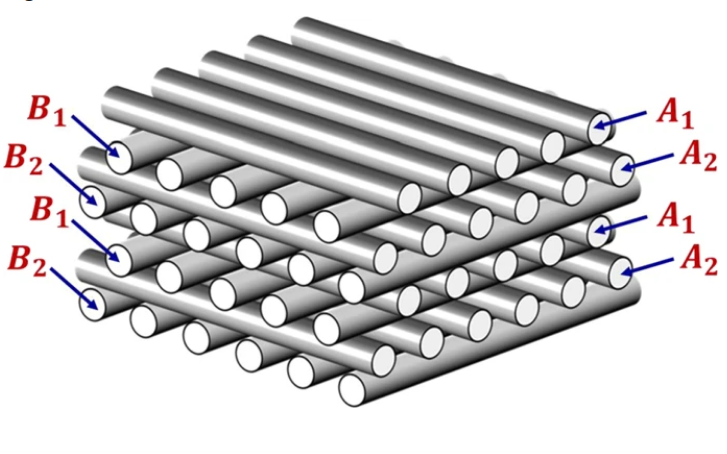In the recently published ‘Age-aware constitutive materials model for a 3D printed polymeric foam,’ authors A. Maiti, W. Small, J.P. Lewicki, S.C. Chinn, T.S. Wilson, and A.P. Saab explore the possibilities of fabricating 3D printed microstructures that will out-perform and out-live traditional foam.
The authors report on their findings after creating a sample in the form of a thermal-age-aware constitutive model for a 3D printed close-packed foam structure under compression. Such materials are in demand for applications like automotive, aerospace, construction, and packaging. The new method for creating polymeric foams produces uniform layers in each structure, and properties are easily customized for industrial users. Greater longevity is an enormous benefit too as many industries store parts for long periods of time—allowing for breakdown of conventional foams, and eventually damage to products too.
“The enhanced stability of the AM foam was attributed to superior stress distribution within its more uniform architecture,” stated the researchers.
The sample created for this study was meant to be simple yet capable of defining the progress of both the compression set (CS) and load retention (LR). Using the materials model as a vehicle for demonstrating the foam as a continuum, they based it on the following:
“initially (t = 0) there is a single network that governs the mechanical response of the foam. Under long-term strain (compression in our case) a second network forms that is in equilibrium at the strained state. While the material is under strain, the first network progressively weakens (i.e., decreases in modulus), while the second network becomes stronger, with a resulting shift in the equilibrium thickness that results in CS. On the other hand, LR results from a joint effect of the altered equilibrium thickness and changes in mechanical modulus in both networks.”

Schematic diagram of a 3D printed foam with the face-centered tetragonal (FCT) architecture used in the present study. It is made of Dow Corning’s polysiloxane-based silica-filled elastomer, called SE-1700. Each cylindrical strand is of diameter 250 μm with a small overlap between perpendicular cylinders at each junction, resulting in a total thickness of ~1.6 mm for the eight-layer structure. Initially printed samples had in-plane dimensions 75 × 75 mm square (uniform thickness 1.6 mm), out of which circular discs of diameter 28.7 mm were cut for use with aging and mechanical response study.
Eight samples were aged for 14 months, with four different temperature settings, and measurements taken around once a month. To begin, printed samples were sized at 75 × 75 mm square, with a uniform thickness of 1.6 mm. The researchers cut circular discs, with a diameter of 28.7

Time and temperature dependence of: compression set (CS); load retention (LR); Shear modulus μ10 of the original network; and shear modulus μ11 of the induced network. Each point in these graphs are obtained by optimized fitting of the experimental stress-strain response with the Ogden + Tobolsky model at each time and temperature, averaged over two samples for each isotherm.
3D printed models used had a total of five parameters, and the researchers explain that they expect to use their samples for ‘thermal aging’ of stochastic foams, although experimental aging data is still required.
“Through accurate fitting of experimentally measured stress-strain curves at different times and temperatures, the model yields the functions μ10(t, T) and μ11(t, T). Additionally, we also back out quantities like compression set (CS) and load retention (LR) out of the model (see Eqs 5 through 8), two fundamental metrics that are used to quantify the mechanical/structural aging of polymeric components in real systems. The method of Time-temperature-superposition (TTS) is then used to create long-term prediction curves of each of these four quantities, along with margin curves for uncertainty quantification,” concluded the researchers.
“For the printed foam, we observe roughly the same activation barrier (ΔE ~ 83–86 kJ/mol) for the evolution of all four properties (i.e., CS, LR, μ10, and μ11), which is consistent with a single dominant molecular/network level mechanism governing the aging of all such properties.”
3D printing has been highly useful for industrial applications, and specifically the area of packaging—whether for sensors, glass, or food, beverage, and retail packaging. What do you think of this news? Let us know your thoughts! Join the discussion of this and other 3D printing topics at 3DPrintBoard.com.

Master curves generated from the plots in Fig. 3 through time-temperature-superposition (TTS) at a reference temperature Tref = 25 °C. We used the bootstrap-mean-minimum-arclength implementation of TTS as described in ref.30. Each property displays nearly the same Arrhenius barrier (in KJ, as indicated). Dashed lines are modified exponential fits to the master curve and can be used to make long-term predictions.
Subscribe to Our Email Newsletter
Stay up-to-date on all the latest news from the 3D printing industry and receive information and offers from third party vendors.
You May Also Like
Gorilla Sports GE’s First 3D Printed Titanium Cast
How do you help a gorilla with a broken arm? Sounds like the start of a bad joke a zookeeper might tell, but it’s an actual dilemma recently faced by...
Nylon 3D Printed Parts Made More Functional with Coatings & Colors
Parts 3D printed from polyamide (PA, Nylon) 12 using powder bed fusion (PBF) are a mainstay in the additive manufacturing (AM) industry. While post-finishing processes have improved the porosity of...
$25M to Back Sintavia’s Largest Expansion of Metal 3D Printing Capacity Since 2019
Sintavia, the digital manufacturing company specializing in mission-critical parts for strategic sectors, announced a $25 million investment to increase its production capacity, the largest expansion to its operations since 2019....
Velo3D Initiates Public Offering in a Bid to Strengthen Financial Foundations and Drive Future Growth
Velo3D (NYSE: VLD) has been among a number of publicly traded 3D printing firms that have attempted to weather the current macroeconomic climate. After posting a challenging financial report for 2023,...





























